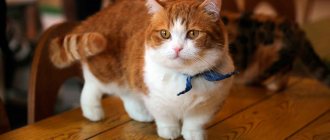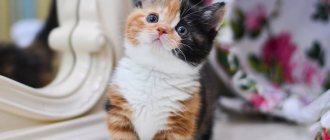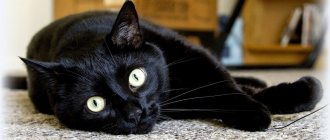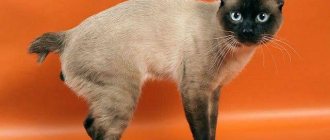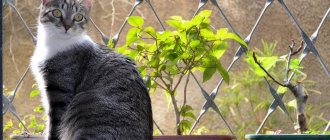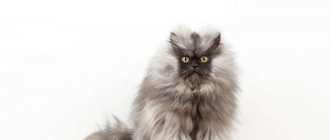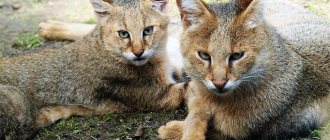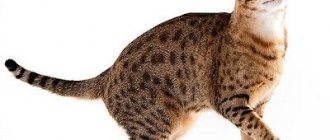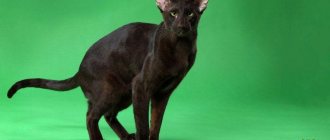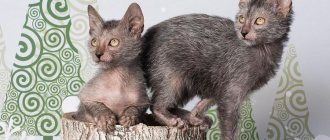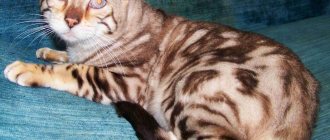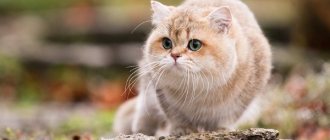The most popular hybrid spotted cat breeds
Most of these are animals obtained by crossing with wild cats.
Bengal
A hybrid of the Asian Leopard Cat or Lesser Leopard (ALC) and a domestic cat, bred by American breeder Jean Mill. Selection work began in 1961. Today the breed is recognized by all felinological systems of the world. The animal has been a pet since the fourth generation.
The first individuals were exclusively “golden” in color - there were black spots on a red background. With the development of the breed, pets of different colors were obtained:
- silver - the main background is silver;
- snow - in three modifications - linx, mink and sepia;
- marble - the spots merge into a large “cloak” or “sparble” pattern;
- charcoal - on a black background there are marks of the same color, while this is an experimental color.
snow bengal
charcoal bengal
Today, especially popular are individuals whose spots on the skin are located in the form of “rosettes”, reminiscent of the pattern of a jaguar’s fur. The most valuable pattern consists of three colors.
Even Bengals of the Siamese-Himalayan type have been bred. But no matter the color, the coat is the main distinguishing feature of this breed. It must have a “wild” pattern and is of the highest quality - short, without undercoat, tightly adjacent to the muscular body, glittery.
A kitten experiences phasing at two to five months, a process characteristic of wild cats. The bright pattern is hidden under the long secondary hair. The baby “blooms” to the age when his physical development allows him to protect himself from enemies and obtain food, in full accordance with natural canons. Excessive hair loss occurs only during this period of time; in adult life, the Bengal cat does not shed. This charming animal is rightfully called the “domestic leopard” due to its exceptional exotic coat pattern and energetic temperament.
Toyger
This is a “defective” Bengal, in which the standard prohibits the merging of spots into stripes.
The genetic fixation of this deficiency helped the emergence of a new breed. It was created by Judy Sugden, daughter of Jean Mill. Not all felinological systems have yet received recognition.
Toyger
The colors of the Toyger are the same as those of the Bengal cat.
Savannah
The largest modern cat breed. It is a hybrid of Serval and Abyssinian. Registered by breeder Patrick Kelly in 2001 in the American felinological system TICA.
Savannah got the leopard coloring from a wild ancestor. Its color varieties are gold, silver, brown (ed), chocolate, cinnamon.
Savannah
By nature, these cats are very curious and intelligent, easy to train. They do not tolerate loneliness well. Active, jumping and busy pets need a lot of space to play and love water very much.
Serengeti
A hybrid of Bengal and Oriental was created in California in 1994 by breeder Karen Sauzman. Due to its close resemblance to the Bengal cat, the breed is not widespread. Registered only in the American TICA system.
Habitat of rusty cats and role in the ecosystem
There are two separate subspecies of spotted-red cats that live in different conditions and in different territories:
- Indian (Prionailurus rubiginosus rubignosa) - inhabit the southern and eastern regions of India (the states of Kashmir, Gujarat, Jammu, etc.), open dry areas, rocky areas and impassable bushes;
The Indian Rusty cat has a gray coat color and more pronounced, clear stripes on the back and head.
- Ceylonese (Prionailurus rubiginosus Phillips) - live on the island of Ceylon (Sri Lanka), in tropical wet and dry deciduous forests, in mountainous and lowland tropical jungles, as well as in densely bushy meadows.
The Ceylon rusty cat has a more buffy red color and a fuzzy pattern on the skin.
These predators prefer to settle near waterways and various bodies of water.
There is a version according to which rusty cats were pushed out to the open, dry areas of the Indian subcontinent by their close relatives, Bengal cats. Small predators were unable to compete with their larger counterparts and were forced to adapt to other living conditions. There are no Bengal cats in Ceylon.
The most popular spotted breeds of domestic cats
The tabby color is also found in breeds bred without crossing with wild cats.
Ocicat
In appearance it resembles the brightest cat in the world, Ocelot, and got its name in honor of him. Although it has no relationship with a wild cat, but was obtained by crossing a Siamese and Siamese-Abyssinian mestizos.
By its temperament, the Ocicat is a cheerful and playful pet, loyal and affectionate, sociable and loving.
The colors vary in color, but always with spots.
Egyptian Mau
Descended from common street cats of Cairo. Exported to America in the fifties of the last century. One of the oldest natural breeds in the world.
The color of the short, dense coat can be different - silver, bronze, smoky, pewter. But always a tabby - and only a dark spot. A distinctive feature of his appearance is the “scarab” mark on his forehead and the black “eyeliner” of his expressive green eyes.
This small, muscular and very active cat has a balanced and independent character. She is attached to people, does not like loneliness, and is friends with all pets. Loves to talk with family members. The sounds that the Mau makes are not always like meowing, but resemble the “mumbling” of a person.
And you can learn more about this cat by reading the article about the Egyptian Mau on our portal.
Pixiebob
The Elf with the Short Tail was developed in the United States in 1985. The exact origin of the breed has not been determined; there is a version that wild cats participated in the selection, but this has not been confirmed by anything.
The pixie bob is characterized by the appearance of a lynx with tufted ears and a short tail. Polydactylism is common. The short or semi-long coat is always tabby in color - with spots or “rosettes”.
In their devotion to humans, these cats resemble dogs. Very calm, attentive and observant pets are friendly and love to play with children. They swim excellently, climb trees, hunt, “talk”, making beautiful curling and chirping sounds. They get along well with other pets, but are always leaders.
British Shorthair and Scottish Fold cats
The British and Scottish Fold are essentially different types of the same breed, although they are registered separately in feline systems. These are some of the most popular and oldest domestic breeds in the world.
By nature, these pets are self-sufficient, almost always phlegmatic. They like to sleep, but are not fans of active pastime. They are attached to people, love and do not offend children. Unpretentious and calm.
The colors of these cats are varied, spotted colors are very common.
American Shorthair (Kurzhaar)
This breed developed from its European relatives, who migrated with humans to America. A group of breeders began working on the approval of the variety at the beginning of the twentieth century.
The most famous color is the silver tabby - bright black, rather large spots on a light gray background.
The character of the American is called the “golden mean”, the cat is calm, does not require constant human attention, is moderately active and very devoted to the owner and all household members.
European Shorthair
The spotted color of this oldest breed is widely popular. The oldest European native variety was registered and presented to the public only in 1982.
A kind, energetic animal is deeply devoted to humans, willingly plays with children and at the same time never loses its hunting instincts.
Siberian
This natural oldest Russian breed most likely descended from Oriental cats brought to Siberia by merchants.
Animals with long hair and a thick undercoat are excellent hunters and have an independent and calm character. They are sincerely devoted to the owner and all household members, but do not like attention and affection imposed on them.
Among the many colors of Siberians, tabby is common.
Maine Coon
The raccoon cat is the pride of Americans. This natural breed has long been in the lead as the largest. The size of an adult cat (length with tail) reaches one and a half meters and weighs sixteen kilograms.
This pet is calm and undemanding, friendly and devoted to humans. But at the same time, like its ancient wild ancestor, it is an excellent hunter.
The colors of the coon are varied, spotted is quite popular.
Curly
The variety of breeds of domestic cats is truly amazing, since everyone can choose a pet, as they say, “to their own taste and color”... Well, curly-haired animals deserve special admiration, which in terms of external unusualness are often superior not only to their long-haired and short-haired relatives, but even hairless “brothers”.
Cornish Rex
short, soft, silky, relatively thick and, most importantly, curly hair, giving a “astrakhan” appearance, a graceful body with a “dry” build and long paws, an elongated muzzle with large ears and wide-set oval eyes, curly and long mustaches and eyebrows .
more details
Devon Rex
short and curly but soft fur, unusually large ears set low at the edges of a wide flat head, a small head with large eyes set wide apart and strongly curled antennae, a gracefully built body of medium size with long and strong paws.
more details
German Rex
short but soft and elastic coat, slightly curly, curly whiskers and whiskers on the eyebrows, athletic and muscular body of medium size with proportional limbs, widely spaced round eyes of a uniform color corresponding to the main color.
more details
Oregon Rex
curly and silky, but very short hair, sparser on the bristles, a neat elongated body with long legs, a medium-sized wedge-shaped head with high cheekbones and prominent mustaches, while the mustaches themselves are short and curly, large ears with rounded tips and barely noticeable tassels .
Laperm
short or long hair, but elastic and curly, most curled on the belly, neck and at the base of the ears, normal build with paws of medium length, wedge-shaped head with slightly rounded contours and rounded whisker pads.
more details
Bohemian rex
curly semi-long or long hair, most luxurious around the neck and on the “pants”, but without curl on the face and ears, powerful build with a dense and rounded belly, large and expressive eyes with a color that matches the main color.
Skookum
skokum
curly hair (can be short or long), short but strong legs (the front legs are slightly shorter than the back ones), a compact and dense body with rounded contours of the head, a long tail of medium thickness.
Ural rex
wavy coat of short to medium length, dense and full, silky texture, muscular but rather short body of medium size with a wedge-shaped head and slender paws.
The rarest spotted cats
Leopard-colored cats are also among the new experimental breeds that have not yet found recognition.
Australian Smoke (Mist)
Breeder Labor Street from Sydney carried out enormous selection work, which involved simple and purebred cats - Abyssinian, Siamese, Burmese. Among the many colors, tabby is one of the most common.
Mist inherited excellent health from the barn cats, and extraordinary grace and dignity from the elite. Gets along well with any pet, is devoted to people, loves children, is active and energetic. Approved by a limited number of felinological organizations, it is not widely distributed.
California radiant
Despite its wild appearance, this is not a hybrid breed, but a mixture of many varieties of cats - British Shorthair, Manx, Siamese, Angora, Abyssinian.
Created by American screenwriter Paul Casey as a symbol of wild African cats, mercilessly destroyed by humans. Very smart, friendly, silent and undemanding pets are still very rare and are registered only in the TICA felinological system (USA).
There are eight colors - black, brown, blue, bronze, charkoal (smoky anthracite), red, gold and silver. Always tabby.
Ussuri cat
This natural breed was noticed relatively recently. Most likely, it came from crossing Amur and Siberian cats.
It has been registered as experimental since 1994, but so far its representatives are very rare in the world.
The main color is from golden to fawn, always tabby. A very independent, self-sufficient and proud pet has all the habits of a predator. Temperamentally, he is more like the latter. Doesn't get along well with other animals, is a loner by nature and an excellent hunter.
Soukok or Sokoke (Kenyan Forest Cat)
It is believed that the ancestors of this very rare breed are wild kazonzo and secondarily feral domestic cats.
Through the efforts of the English breeder Jenny Slator, the breed was approved in 1992 in Denmark.
These slender and lithe cats are small in size, but strong and muscular. The dense and short coat can be of different colors, but always tabby, usually merle.
Playful and very intelligent animals are quite willful and independent. At the same time, they get along well with both humans and other pets. Wonderful hunters.
Reproduction and lifespan
Breeding cats of this breed is far from easy. And there are several reasons for this. Firstly, the characteristics of lynx kitties play a role here: their conservatism, aversion to changing places, as well as semi-wild roots, despite their almost canine nature. This sometimes seriously prevents owners of purebred specimens from participating in exhibitions with them.
Here, beloved pets, seemingly docile and affectionate at home, can show wariness and aggression, which will not be easy to cope with. As for matings, difficulties arise in this issue again. Pixiebob genes are special. Therefore, they cannot be arbitrarily crossed with any desired breeds, but only with each other. And this makes it very difficult to choose a partner.
And most importantly, this breed of cat was bred in North America and is now mainly bred only in the USA and Canada; moreover, it is considered the national treasure of these countries, and therefore the export of such kittens to other continents is difficult. Because of this, a purebred pixie bob is still considered a rarity in Russia.
And the number of specimens we have does not yet allow us to create a worthy domestic population. All this makes the breed insufficiently known in our country, and therefore arouses little interest among breeders and prospective owners. Although nurseries for breeding elf-lynxes are still appearing, including in Moscow.
An interesting feature of kittens of this breed is their late maturation and formation. Therefore, for an amateur, given the rather large size of domestic lynxes, it is sometimes not difficult to mistake an immature individual for an adult. And the full life cycle of a pixie bob from birth to death is usually no more than 13 years.
Wild spotted cats - pets
Wild leopard cats are very beautiful. The fashion for keeping them at home has arisen more than once in the human community. But not all representatives of the cat world can be safely placed in a house.
Today, only three spotted species are most widespread as pets.
Serval
The African bush cat is a medium cat. Body length with a short tail is up to one and a half meters, weight - up to twenty kilograms. A small head, long legs and high-standing large ears make this animal look like a cheetah.
In order for a Serval to grow up tame, it must be taken away from its mother in the first days of life and fed by hand. Therefore, you should only purchase such a pet from experienced breeders.
A properly raised kitten will grow into a friendly cat, but its wild roots must not be forgotten. An adult must have a separate enclosure.
Food: raw meat only. During growing up, great attention should be paid to ensuring that there is enough calcium in the diet. Children have fragile limbs and fractures often occur.
The Serval's coloring is magnificent - dark spots on a reddish background.
Read more photos and interesting information about the serval in a separate article on Mister Cat.
Ocelot
A very bright animal, resembling a leopard in appearance, although smaller in size.
Less accommodating and less trainable than the Serval. An adult should only be kept in an enclosure. Nevertheless, it is often found today in home keeping because of the extraordinary beauty of its amazing colors. Such a pet named Babao lived with the famous artist Salvador Dali.
Geoffroy's cat
This small wild animal is similar in size to its domestic counterpart.
The brightly spotted skin was highly valued in the fur industry. Today this species is on the verge of extinction and is protected by the CITES Convention.
Therefore, it is now rarely found in home keeping, although it is popular. It is well tamed if at an early age the pet was taken from its mother and raised in the hands of a person. There are only a few breeders of this species, and it is difficult to acquire such a cat.
Peterbald
A breed of elegant, hairless domestic cats with a wonderful character, a smart face and very large ears. The St. Petersburg Sphynx owes its name to the city where it was bred by crossing the Don Sphynx and an Oriental cat.
Sphynxes - hairless cats with huge mouse ears - look exotic and, for many, repulsive. However, the appearance of these animals is very deceptive: sphinxes have a wonderful character. They are smart, playful, very kind and loyal cats. They easily adapt to changes and are trainable. In addition, they are hypoallergenic.
Now there are three breeds of sphinxes, differing, for the most part, only in the configuration of the body and head:
- Canadian Sphynx,
- Don Sphynx,
- Peterbald.
| Sign | Description | ||
| Canadian | Donskoy | Peterbald | |
| Body type | The body is strong, stocky, short, rather fit | Strong, wide. The belly is round | Long, lean. The belly doesn't stick out that much |
| Head | Medium or large sizes, wide. Pronounced cheekbones, short nose | Medium size, round. Flat forehead, short nose | Small in size, long and narrow. Long, straight nose |
| Eyes | Oval, large, can be any color | Almond-shaped, slanting. Any color | Large, almond-shaped or round, slanting. Color yellow, blue or green |
| Ears | Large, widely spaced. Wider towards the middle, ends rounded | Triangular, elongated. Set high, slightly inclined forward, ends rounded | Wide at the base, set at a large angle, ends rounded |
| Tail | Long or medium length, thin | ||
| Limbs | Medium length, thin but strong. Large paws and long fingers. | Middle length. Paws are medium-sized, rounded | Long, thin. Large paws with long toes |
| Wool | There is no or slight pubescence of the muzzle or the entire body | ||
| Color | The skin can be gray, pink, black, reddish. Any combination of these colors is allowed. |
Peculiarities of behavior of spotted cats
Spotted coat coloring is the best camouflage for a predator. Pets with leopard coloring carry the gene of wild ancestors in their blood or are as close to them as possible. This explains their energetic and active character. Such animals need a large space for play, often love water and swim well, and are excellent hunters and fishermen. Like any wild cat, they are independent and self-sufficient. You should not try to forcefully pick them up, sit them on your lap, or play with them. Little “leopards” will come to a person on their own when they see fit.
Spotted cats are very smart, real intellectuals. They easily learn the simplest commands, remember a fairly large set of words perfectly, and quickly get used to wearing a harness.
With proper early education, they socialize well and never show aggression.
They are very attached to their owner and yearn for loneliness. It is better to keep such animals in the house in pairs. Then, in the absence of household members, they will perfectly occupy themselves, quickly make friends with any other pets, but will always remain leaders. Just don’t introduce them to parrots or rodents - most likely, the hunting instinct will be stronger than their liking. For pet “leopards” it is necessary to purchase a large play complex, exercise equipment and interactive toys. Their energy always requires an outlet.
Spots and stripes on a cat's fur are an amazingly beautiful pattern created by nature. Spotted domestic cats of different breeds are distinguished by their grace and love of life.
Australian mist
Australian Mist These four-legged spotted coats were developed in Australia (the only cat breed developed in that country) by crossing local street animals with Burmese and Abyssinian breeds. Caring for these cats with a calm, flexible, moderately active and easy-going disposition has no specific features. It is based on regular brushing, bathing as needed (note that mysts do not like water), cleaning the ears, eyes and teeth, as well as shortening the nails.
Australian Mist
These animals love to spend time in secluded places, so your pet’s bed should be placed in a corner hidden from prying eyes. Australian mysts are taking their lack of access to the outdoors in stride. However, walks will be useful for them, if only because these cats have a tendency to gain weight, and walking is a great way to prevent your four-legged pet from developing obesity.
These animals are picky in terms of food, so you need to make some efforts to please such a pet. Mists are very clean and will not tolerate a dirty litter box.
Spotted cat breeds
Spots on the fur are characteristic of all wild representatives of the cat family. Large animals such as the leopard, ocelot, serval, speckled cat (fishing cat), Geoffroy's cat, European forest cat and many other species can wear a skin with various inclusions.
Bengal Cat running and jumping in Snow
Spotted kittens are very beautiful and playful
Spotted domestic cats inherited the coloring from their wild relatives. A cat with spots can be found in almost every breed. At the same time, you should know that all felines have a pattern on their fur (stripes or spots), but not all of them have it visible.
Interesting fact! Spotted cats, which are also called “sprat” cats, seem to some people to be unattractive and ugly. Absurd delusion! Variegated colors adorn the pet.
Pixie bob
The pixie bob or short-tailed elf is similar in appearance to a lynx. Breeders achieved this unusual look after long experiments in crossing domestic cats with wild short-tailed cats, residents of American and Canadian forests.
The pixie-bob looks like a miniature lynx: the same tufts on the ears, the same eye shape. The thick silvery or brownish coat is covered with small dark spots.
Short-tailed elves are very affectionate and sociable, they love to play and even swim. A short tail and multiple toes are the distinctive features of pixie bobs.
This is interesting! All cats of this breed have additional toes, their maximum number can reach 28 - 7 on each paw.
Savannah
In the 1980s, breeders crossed the domestic cat with the African Serval, resulting in the Savannah breed.
A large, long-legged cat with spots weighs up to 15 kg and grows up to 60 cm at the withers. Outwardly, it looks like a leopard. Savannah's ear can rotate 180°, which allows its wild relatives to perfectly navigate in open space.
Savannahs are distinguished by rounded ears and thick, spotted fur that is chocolate, golden or silver in color with black spots. These animals have a calm, balanced character and developed intelligence.
They are very active, love walks and swimming, and need to exercise a lot. A spotted Savannah cat can make sounds that are unusual for domesticated pets, for example, hiss like a snake. With this hissing, Savannahs not only express their displeasure, but can also warn of danger.
Ocicat
The breed of domestic cats, resembling the color of their wild relative the ocelot, is called Ocicat.
Despite the external similarity and the name of the breed, the Ocicat is not a descendant of the ocelot. This domestic breed was developed in the second half of the twentieth century as a result of crossing Siamese, Abyssinian, American Shorthair and some other spotted cats.
After several experiments, graceful spotted kittens were born. The Ocicat has a long muscular body, graceful thin legs, and a head in the shape of an elongated triangle. The coat color can be blue (silver), ivory or cream.
There are small dark spots all over the body. There are horizontal stripes on the neck that resemble a collar. You can see “rings” on the paws.
This is interesting! The Ocicat is a very affectionate, playful cat. She easily learns new things: a smart cat will quickly learn to bring a fallen object to its owner.
The spotted favorite of the Ocicat breed does not tolerate loneliness well and needs communication with humans and other pets or relatives. This graceful animal loves to run and jump, so it needs toys and space to play. Ocicats are in good health, but may have problems with their teeth and gums, so they need to be cleaned periodically. But short hair is not difficult to care for.
Fold cat
Spotted tabby is one of the colors of the Scottish Fold cat. Dark spots are visible on the legs, body and tail. Black lines are visible around the eyes and nose.
The spotted cat has the floppy ears characteristic of the Scottish breed. Clearly defined small and large spots are located throughout the body. The coat can be silver, cream, or bluish. These are calm and affectionate pets who love to play and communicate with people.
Scottish Fold Spotted Tabby
Ussuri
The Ussuri cat appeared in the Far East as a result of natural crossing of the domestic Siberian cat with the Amur forest cat. In the wild, Siberian cats mate with Amur forest cats, resulting in large spotted kittens. The breed was not specially bred; moreover, the efforts of breeders did not improve it at all.
For reference! Ussuri (leopardette) is a small breed that has not received recognition outside of Russia.
The Ussuri breed has a powerful, muscular body, full cheeks and rounded ears with tufts. The thick, short, shiny coat is golden, fawn or brown, covered with black or bronze spots, stripes and rings. The dense and thick undercoat reliably protects this cat from the cold.
Ussuri are friendly, but they cannot be called affectionate. They have an independent and independent character. It is advisable to keep such pets in a country house so that the animal has its own territory. Ussuri love silence and solitude. They have highly developed hunting qualities. They have good health, so they require simple care: regular vaccinations, washing and combing their hair.
Important! Ussuri is a very rare and small breed.
And others
Representatives of a wide variety of breeds can be spotted. Among them are the most common:
- Asian tabby;
- American Shorthair;
- American Bobtail;
- American Curl;
- Arabian Mau;
- Bengali;
- Bristol;
- Egyptian Mau;
- European Shorthair;
- California radiant;
- Kanaani;
- Cymric;
- Kurilian Bobtail;
- Serengeti;
- chito.
The fur of cats of these breeds has clear, bright spots that form an interesting and beautiful pattern. In other breeds, spotting is also sometimes present, but not so pronounced.
What to look for when choosing a kitten
Ashera is the most expensive cat. Even a fifth-generation mixed breed costs much more than a purebred (for example, British) kitten with a pedigree. The high cost is associated not only with the exclusivity of the breed, but also with the peculiarities of breeding. Today, you will have to pay at least one and a half million for a pet, fortunately, in rubles. However, every year the price of kittens only increases.
Before buying a pet, you should make sure of its physical and mental health. Active, playful and social, Asher kittens should not show displeasure when interacting with their future owner. Also, babies should not be too thin or overfed. A rounded tummy, in which you can easily feel the ribs, is an indicator of the cat’s normal nutrition.
You should inspect the living conditions in the nursery. Cats of this breed need a lot of space to live and play, large toys and scratching posts. Often a tree is placed for pets, along which they happily climb to the ceiling.
You should buy an animal only after installing a chip and receiving a veterinary passport with all the necessary vaccinations.
Breeders often require early booking as a condition of purchase. Long before the cat gives birth, you can make an advance payment for your future pet, and then wait several months until it is born and gets stronger. Only after this you can choose a kitten for yourself. Another sign of a quality breeder is the sale of a cat at the age of 12 months after castration. Sterilization is necessary to prevent wild genes from waking up.
Ashera is rightfully considered one of the best cat breeds. A graceful, intelligent and delicate cat will be an ideal companion for walks, active games, and relaxation. The beauty and perfection of a pet will not leave anyone around you indifferent and will make a lasting impression.
Origin of spotted color in cats
Many modern scientists are confident that the Libyan spotted cat became the ancestor of the domestic cat. From her, all modern representatives of domestic purrs have inherited the genes responsible for their spotted coloration.
For reference! All cats have a pattern on their fur, but it is not always noticeable. Even a completely black or white cat may have stripes and spots of the same color, but this pattern cannot be seen.
The presence of the dominant gene A (agouti factor) in the cat’s genome determines whether the pattern on its coat will be visible. Spotted cats inherit several genes responsible for their pattern and its location.
Domestic animals of spotted color first appeared in the 18th century in England. Spotted is a type of tabby color. This includes any colors with patterns.
There are 4 types of patterns: spotted, brindle, marbled and ticked. All tabby cats have noticeable M-shaped stripes on their foreheads.
A cat's eyes may be lined with black, brown, red, lavender, blue or pink, depending on the base color of the coat. In the wild, tabby coloring and spotting are needed for cats to camouflage against leaves and grass. The spotted color combines the characteristics of other tabby species. The spots resemble broken tiger stripes or the streaked patterns characteristic of marbled cats.
Signs of spotted color:
- the spots form a clear line along the length of the entire body from the withers to the tail;
- “buttons” are noticeable on the stomach;
- "necklace" on the neck.
Spotted color cannot be determined for sphinxes, as well as for other varieties (acromelanic, harlequin, van).
Spots with clear boundaries can have any shade: cream, red, blue, chocolate, black, lilac, fawn and cinnamon. The spots are evenly distributed throughout the animal's body. The background is much lighter than the spots.
Spotted cats have noticeable M-shaped stripes on their foreheads.
Egyptian Mau
This is a slender, well-built cat of medium size. Her features are a fold of skin on her stomach, thanks to which the Egyptian is capable of impressive jumps, and a unique eye color of an interesting shade of green, which is compared to the color of an unripe gooseberry. Her character is sociable and friendly.
Egyptian Mau are descendants of the very cats that were so revered in Ancient Egypt. The history of the breed (in the modern sense) began more than a hundred years ago, but almost ended during the Second World War. The restoration of the breed was undertaken by the Russian princess N. Trubetskaya. Of course, it is difficult to say whether the ancestors of modern Egyptian women were descendants of those same ancient Egyptian cats, but it is reliably known that the princess imported animals for breeding work from Cairo.
Features of caring for domestic cats
A loving owner cares about the health of his pet. Spotted felines are active and curious, so they sometimes get injured. You need to carefully monitor their behavior and, if possible, prevent trouble.
All pets must be vaccinated against infections. This will protect your furry pets from many deadly diseases. In general, spotted cats do not require any specific care. They need to be cared for just like any other furry pet.
Grooming
Almost all spotted cats are short-haired, so brushing them once every 1-2 weeks is sufficient. Cats are very clean animals, so they only need to be washed if the pet gets dirty in something.
Cats keep their fur perfectly clean
Food for spotted cats
These animals are very active and spend a lot of energy, so they need a balanced, nutritious diet, like all other cats. It is advisable to feed them the best premium food that contains all the necessary nutrients.
Your cat's diet should be balanced
The spotted cat is a source of joy in the home. You can admire her endlessly. Motley beauties need care and love.
Cat breeds that look like tigers look very attractive and unusual. These days, such pets are no longer uncommon, but this was not always the case.
The American geneticist P. Casey was involved in crossing wild and domestic animals with a spotted coat. The result is that spotted cats have become suitable for living with humans.
Toyger
The Toyger is a breed for those who would not mind having a tiger in their home. Representatives of this breed really resemble wild tigers, but in a mini version. They have a muscular body, brindle color, and short dense hair. However, their disposition is not at all predatory: they are very affectionate and friendly, like diligent pets. Translated, “toyger” means “toy tiger.”
Toygers are smart and highly trainable, and can be trained. They are sociable and playful and love to have fun. Find a common language with most people and animals.
They choose a master for themselves, to whom they are endlessly devoted. At the same time, the toyger is unpretentious and does not require increased attention to itself. Therefore, this breed is perfect for those who often leave the house.
The most popular spotted cat breeds
If you want to have a spotted cat that looks like a leopard, future owners are advised to take a closer look at the following breeds:
Bengal
As a result of a genetic experiment, a breed of Bengal cats appeared. The scientist crossed leopards with ordinary outbred domestic cats.
Bengals are animals with a long, slender body and legs. The coat color varies from gray to brown. All individuals have oblong black spots on the body.
Bengals are a breed of spotted cats that are most similar to a leopard. In fact, the Bengal cat is a descendant of the leopard, although it has the character of a pet.
Features of Bengals:
- Sociable;
- Smart;
- Non-aggressive;
- Trainable;
- They love to swim.
The average price of a Bengal kitten is 10 thousand rubles, animals with a pedigree cost up to 50 thousand rubles.
Pixiebob
The breed was bred at the beginning of the 2000s. The selectors were faced with the task of creating spotted cats that looked like a lynx. Pixiebobs are a hybrid breed with a short tail (which is why the cat gets its name).
From the photo, pixiebobs are very similar to miniature lynxes, they:
- Get along well with other animals;
- Not aggressive towards people;
- They are affectionate and strongly attached to people.
Pixie beans were created artificially and relatively recently, so they have not become widespread.
Kittens are quite expensive, the cost of a pixie-bob starts from 40 thousand rubles.
Ocicat
That is the name of the cat breed obtained by crossing Siamese and Abyssinians. The name of the Ocicat breed is consonant with wild ocelots, because... cats look exactly like these animals. The breed was bred by the American V. Dale randomly.
Ocicats:
- Cannot have blue eyes;
- They do not have wild ancestors;
- The color can have many shades, up to smoky blue;
- Character – calm, friendly.
Ocicats are quite large, have high, oblong ears and almond-shaped eyes.
The price of an Ocicat kitten ranges from 35 to 160 thousand rubles.
Serengeti
A young breed, artificially bred in 2001. The ancestor of the Serengeti was Bengal cats, which is reflected in the color with clearly visible spots.
Serengeti cats:
- Curious, love to explore their surroundings;
- Aggressive towards some objects and animals, but not towards people;
- They do not get along well with dogs.
The price of a Serengeti kitten is 35 – 60 thousand rubles.
Australian smoke
The cat breed is like a leopard, but it occurred by crossing the Burmese and Abyssinian breeds. The Australian smoky cat has a bluish color; there are individuals with a marbled coat.
The breed has the following distinctive features:
- The body and head are medium in size;
- The ears are elongated, wide at the base;
- Almond-shaped large eyes;
- Friendly character;
- Not prone to aggression.
California radiant
Leopard cat, obtained in the USA after crossing three breeds. They have short fur of various colors with a brown tint.
Features of the Californian Radiant breed:
- A special gait, like that of wild cats;
- Very long, thin tail;
- The spots are round, square or triangular in shape.
The breed was bred in 1970 and has since been popular in the United States and around the world. California shining middle class kittens cost from 90 thousand rubles.
The offspring of premium individuals with a pedigree can cost up to 150 thousand rubles.
Serengeti
This is a relatively new breed, having appeared in the 1990s. They are descendants of a Bengal cat crossed with an Oriental cat. They have very long ears and paws. This breed is very active, loves to spend time with people, and has a loud voice. They can also get along with other pets if introduced properly.
Skunk.
Skunks live in North America in small families or alone. Cute animals have an unusual black and white color. Representatives of the animal world that have light stripes on their backs have a unique ability.
Glands located under the tail secrete fluid in defense against predators. The smell is so pungent that it repels any enemy.
Hyena.
Small predators live in Africa and prefer to be in a pack. They are dangerous not only for mammals, but also for travelers who may encounter a hyena during their trip.
Spots on the fur help in hunting; with their help, animals externally merge with the ground and stones. The color allows them to be invisible to the victim and wait for the right moment to attack. Predators are difficult to spot in nature when they move around. There are few spotted hyenas left on the planet; the species is listed in the Red Book.
Fold cats
These animals are native to Scotland. They have a distinctive feature and these are their unusual ears. Cats' ears are slightly turned forward, slightly shifted at the edges, and the ends are round.
As soon as the kittens of these breeds are born, they do not look at all like the animals of these breeds, and after a month they acquire all the forms she needs. Fold cats have large eyes, small hair and a round muzzle. Coat color in mono or mixed style. The character is calm and affectionate, they can stand on their hind legs, and their voice is creaky.
Savannah is half Serval
This large (up to 60 cm at the withers) spotted hybrid cat, originally from America, tops the list of the most expensive pets. Serval and Bengal blood flows in her veins. They are incredibly loyal, intelligent, energetic animals with phenomenal memories, which allows them to learn quickly.
Savannah
The most optimal conditions for keeping these large spotted cats is a special enclosure in a private house. Savannahs have a pronounced hunting instinct; they sometimes hone their skills on their owners. It is recommended to wean a kitten from this harmful and sometimes dangerous habit as early as possible with the help of regular outdoor games and toy mice.
Possible tabby colors
Among tabby cats, gray and silver cats predominate with markings of a wide variety of colors: lilac, chocolate, blue, smoky black, reddish. But this does not mean that other tabby colors are rare. In the table below we look at the main variations of tabby color.
Table 2. Possible flower combinations for tabby color
| Color name | Marking color | Leading coat shade |
| Amber | Smoke black | Peach |
| Black silver | Deep black | Silver |
| Blue | Gray dust | Ivory |
| Blue silver | Grey | White |
| Bronze | Dark chocolate | Warm cream |
| Brown | Black night | Gray with brown or copper fade |
| Cameo | Fiery red | Warm ivory |
| Caramel | Milk chocolate with light color | Beige |
| Coal | Black chocolate | Smoke gray |
| Chestnut | Bright brown | Cream with possible orange undertone |
| Chocolate silver | Milk chocolate | Light blue silver |
| Cinnamon | Light chocolate with red flecks | Several shades lighter than the drawing |
| Golden cinnamon | Cinnamon | Ivory |
| Cream | Bright cream | Pale cream |
| Cream silver | Cream | Delicate silver |
| Faun | Light beige with cinnamon | Pale beige |
| Gold | Black | Milk chocolate with light color |
| Delicate amber | Grey, light gray | Tender peach |
| Lilac | Gray with splashes of pink or blue | Light cream |
| Peach | Brown with pink | Delicate cream |
| Red | Fire orange | Several tones softer than the original pattern |
| Purple silver | Lilac | Light silver with lilac splashes |
| Silver | Deep black | White |
It is worth noting that colors may vary depending on the design. Thus, spotted patterns are often presented in warm colors: golden, chocolate, wheat, brown, reddish, red. The classic type combines contrasting patterns of dark stripes on a light background: cream, yellowish, gray. The basis for dark striped patterns is silver and gray. The ticked type offers almost all possible colors. You can read about the mechanisms of genetic inheritance of pigments from cat to cat below.
Pigments and options for their transmission
In addition, the pattern may vary depending on the breed.
Table 3. Tabby color options for different breeds
| Breed | Color name | Marking color | Primary coat color |
California speckled | Bronze, coal, snow leopard, royal glitter | Bronze - chocolate, charcoal - dark chocolate, snow leopard - black, glitter - brown with black | Bronze, snow leopard - ivory, coal - dark gray, glitter - gold |
Egyptian Mau | Mottled Bronze, Smoke Spots, Mottled Tin | Bronze – chocolate, haze – dark chocolate, tin – gray-black | Bronze - cream, haze - dark gray, tin - silver |
Ocicat | Golden cinnamon, sienna, spotted tawny | Cinnamon – chocolate, sienna – beige, tawny – dark chocolate | Cinnamon, sienna - ivory, tawny - red |
| Australian smoke | Golden haze, peach | Haze - golden chestnut, peach - brown with a hint of pink | Haze is several shades lighter, peach is a light cream |
Bengal cat | Leopard, snow | Leopard - red markings in black circles, snow - cream markings in black circles | Leopard – yellow cream, snow – white |
Tabby cats with a rarer color are valued higher - because of this, they can cost more than their counterparts.
